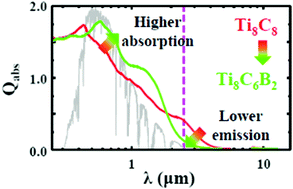First principles investigations of the optical selectivity of titanium carbide-based materials for concentrating solar power applications†
Abstract
To improve the efficiency of concentrated solar power devices and to reach a high conversion rate of the solar energy into heat, a rational design of new high temperature absorber materials is a challenge of prime importance. Ultra-high temperature ceramics can fit the requirements to act as absorber materials, provided that their chemical composition and their properties are finely tuned. Within this context, we investigated the optical selectivity of titanium carbide modified with B, N, O impurity atoms or carbon vacancies, by first principles simulations. By computing the dielectric function and the reflectivity spectra of each composition, we found that modifying TiC can have important consequence on the optical properties of the bulk material, leading in certain cases to an enhancement of the optical selectivity. Then, we assess the performance of nanocomposites made of the corresponding nanoparticles embedded in a silicon carbide media by using Mie scattering theory fed by our ab initio dielectric functions. In this case, we found that while carbon vacancies are detrimental to selectivity, alloying TiC with boron improves notably the performance of the composite material, with an increase in selectivity of about 50%.



 Please wait while we load your content...
Please wait while we load your content...